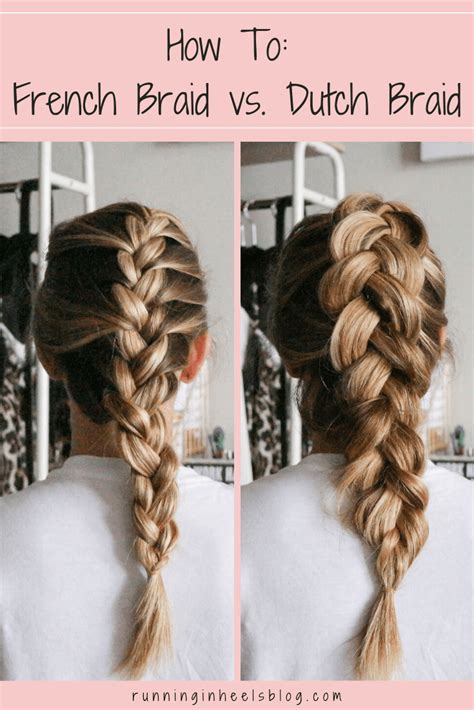1. Introduction
Braids are a timeless hairstyle that has been worn for centuries. There are many different types of braids, but two of the most popular are the French braid and the Dutch braid. Both of these braids are beautiful and versatile, but they have some key differences.

2. The French Braid
The French braid is a type of three-strand braid that is braided from the crown of the head down to the nape of the neck. The braid is created by taking three sections of hair and crossing them over each other repeatedly. As you braid, you add new hair from the sides of your head into the braid.
3. The Dutch Braid
The Dutch braid is very similar to the French braid, but it is created by crossing the strands under each other instead of over each other. This creates a braid that is slightly raised and more voluminous.
4. Which Braid is Right for You?
The best way to decide which braid is right for you is to experiment with both styles. Try braiding your hair both ways and see which one you like better. Here are a few things to consider when choosing a braid:
- Hair type: French braids work well on all hair types, but they are especially flattering on fine or thin hair. Dutch braids are a good choice for thick or curly hair.
- Face shape: French braids can help to soften a round face. Dutch braids can help to define an oval face.
- Personal style: French braids are a more classic and elegant style. Dutch braids are a more modern and trendy style.
5. How to Braid Your Hair
Here are step-by-step instructions on how to braid your hair using both the French and Dutch methods:
5.1 French Braid
- Start by brushing your hair to remove any tangles.
- Divide your hair into three equal sections.
- Cross the right section over the middle section.
- Cross the left section over the new middle section.
- Repeat steps 3 and 4, adding new hair from the sides of your head as you go.
- Continue braiding until you reach the nape of your neck.
- Secure the braid with a hair elastic.
5.2 Dutch Braid
- Start by brushing your hair to remove any tangles.
- Divide your hair into three equal sections.
- Cross the right section under the middle section.
- Cross the left section under the new middle section.
- Repeat steps 3 and 4, adding new hair from the sides of your head as you go.
- Continue braiding until you reach the nape of your neck.
- Secure the braid with a hair elastic.
6. Braided Hairstyles
Once you have mastered the basics of braiding, you can start to experiment with different braided hairstyles. Here are a few ideas to get you started:
- French braid pigtails: This is a cute and easy hairstyle that is perfect for school or casual outings. Simply divide your hair into two sections and braid each section using the French method.
- Dutch braid crown: This is a more elaborate hairstyle that is perfect for special occasions. Start by braiding the top section of your hair using the Dutch method. Then, wrap the braid around your head and secure it with bobby pins.
- French braid bun: This is a sophisticated hairstyle that is perfect for a night out. Start by braiding your hair using the French method. Then, wrap the braid into a bun and secure it with bobby pins.
7. Conclusion
Braids are a beautiful and versatile hairstyle that can be worn by people of all ages. Whether you prefer a classic French braid or a more modern Dutch braid, there is a braided hairstyle that is perfect for you. So next time you are looking for a new way to style your hair, give braiding a try!
8. Frequently Asked Questions
8.1 What is the difference between a French braid and a Dutch braid?
A French braid is braided from the crown of the head down to the nape of the neck, while a Dutch braid is braided from the nape of the neck up to the crown of the head.
8.2 Which braid is easier to do?
French braids are generally easier to do than Dutch braids. This is because the Dutch braid requires you to cross the strands under each other, which can be more difficult to do.
8.3 How long does it take to learn how to braid your hair?
It takes practice to learn how to braid your hair well. However, with a little practice, you should be able to master the basics of braiding in a few hours.
8.4 What are some tips for braiding your hair?
Here are a few tips for braiding your hair:
* Start with small sections of hair.
* Keep your tension even.
* Don’t be afraid to make mistakes.
* Practice makes perfect!
8.5 What are some different braided hairstyles?
There are many different braided hairstyles that you can try. Here are a few ideas:
* French braid pigtails
* Dutch braid crown
* French braid bun
* Fishtail braid
* Waterfall braid
